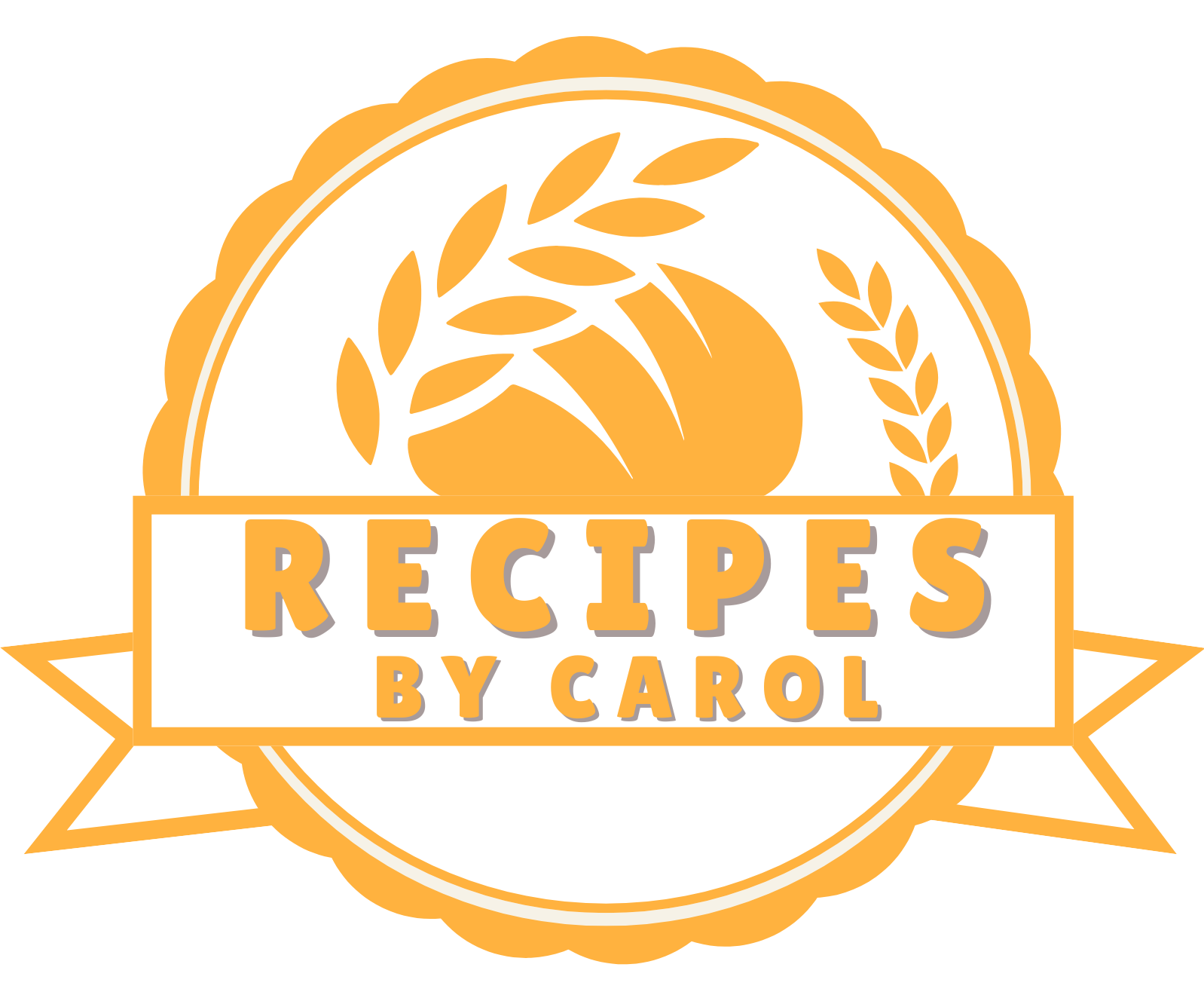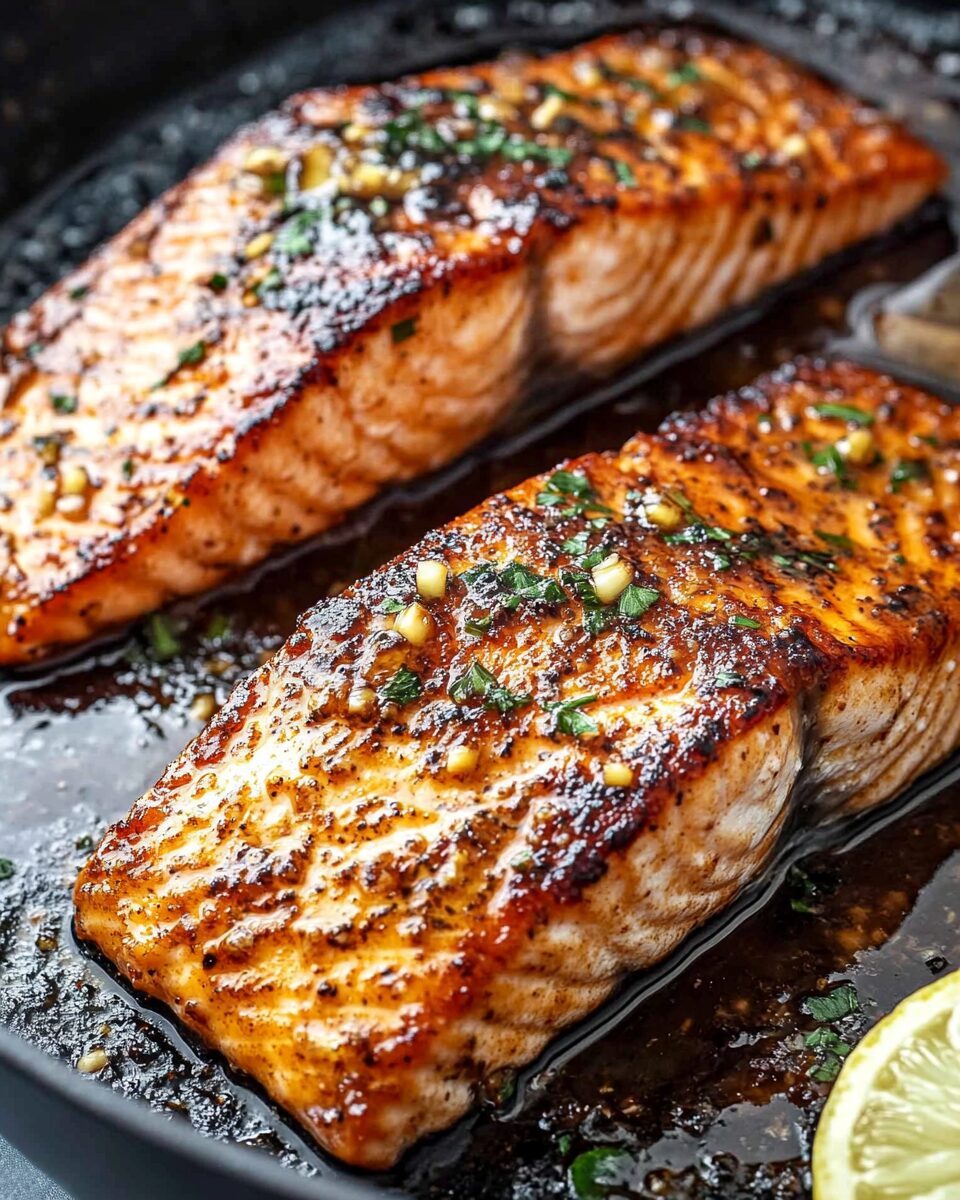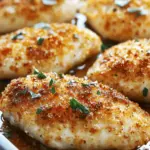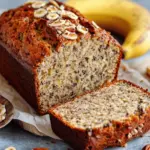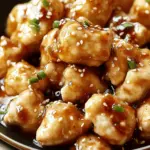This Cajun Honey Butter Salmon combines the rich, bold flavors of Cajun seasoning with the silky sweetness of honey butter sauce. The salmon fillets are seared to create a crispy, golden crust, while the inside remains tender and flaky. With every bite, you’ll enjoy a delightful balance of spicy heat and sweet glaze that melts in your mouth.
Perfect for busy weeknights or special gatherings, this dish pairs beautifully with rice, roasted vegetables, or a fresh salad. The zesty lemon garnish adds a refreshing citrus note, while the black sesame seeds bring visual appeal and a hint of nuttiness. It’s a vibrant, crowd-pleasing dish that’s as easy to prepare as it is delicious.
Full Recipe:
Ingredients:
- 4 salmon fillets (skin on)
- 2 tablespoons olive oil
- 2 tablespoons Cajun seasoning
- Salt (to taste)
- 4 tablespoons butter
- 2 tablespoons honey
- 1 tablespoon soy sauce
- 2 cloves garlic, minced
- Juice of ½ lemon
- Fresh parsley, chopped (for garnish)
- Lemon wedges (for serving)
- Black sesame seeds (for garnish)
Directions:
- Pat the salmon fillets dry with paper towels. Rub each fillet with olive oil and season generously with Cajun seasoning and salt if needed.
- Heat a large nonstick skillet over medium-high heat. Add the salmon fillets skin-side up and sear for about 3 minutes until they form a nice crust. Flip the salmon over and cook for another 2 minutes.
- While the salmon is cooking, melt the butter in a small saucepan over medium heat. Add the honey, soy sauce, and minced garlic. Stir until well combined and simmer for a couple of minutes. Remove from heat and squeeze in the lemon juice.
- Pour the honey butter sauce over the salmon fillets. Continue cooking for another 3-5 minutes, spooning the sauce over the salmon regularly, until the salmon is fully cooked.
- Garnish with freshly chopped parsley, lemon wedges, and sprinkle black sesame seeds on top. Serve immediately.
Prep Time: 10 minutes | Cooking Time: 15 minutes | Total Time: 25 minutes
Kcal: 450 kcal | Servings: 4 servings
At the crossroads of Southern comfort and culinary innovation stands Cajun Honey Butter Salmon, a dish that exemplifies how traditional flavors can transform everyday ingredients into something extraordinary. This delectable creation draws its soul from the vibrant culinary traditions of Louisiana, where Cajun cooking has flourished for generations with its bold spices and unapologetic approach to flavor.
The origins of this particular salmon preparation can be traced to the natural evolution of Cajun cuisine beyond its traditional proteins like crawfish, shrimp, and catfish. As salmon became more widely available across America, innovative home cooks and chefs in the Gulf Coast region began applying their beloved spice blends to this omega-rich fish, discovering that the robust Cajun seasonings perfectly complemented salmon’s natural richness.
What truly distinguishes Cajun Honey Butter Salmon is its masterful balance of contrasting elements. The characteristic Cajun spice blend typically featuring paprika, cayenne, garlic, onion, and herbs creates a warming heat that dances on the palate. This spiciness finds its perfect counterpoint in the sweet, golden honey that’s incorporated into the butter sauce, creating a harmonious sweet-heat experience that has captivated food enthusiasts across the country.
The dish has gained remarkable popularity in recent years, appearing on restaurant menus from New Orleans to New York and becoming a staple in home kitchens seeking weeknight dinners with weekend-worthy flavors. Its appeal lies partly in its impressive presentation the salmon develops a gorgeous caramelized exterior with a moist, flaky interior, while the sauce creates an irresistible glaze that promises flavor in every bite.
The basic preparation involves seasoning fresh salmon fillets with a generous coating of Cajun spices before searing them to perfection, typically in a cast-iron skillet to achieve that coveted crust. The honey butter sauce is crafted separately, often incorporating fresh garlic, lemon juice, and sometimes a splash of bourbon or white wine for depth. When the salmon is nearly finished cooking, the sauce is added to the pan, where it bubbles and reduces, clinging lovingly to the fish and creating a luxurious finish that elevates the dish from simple to sublime.
What makes this preparation particularly appealing to modern cooks is its remarkable efficiency the entire dish can be prepared in under 30 minutes, yet delivers a complexity of flavor that suggests hours of careful cooking. This combination of convenience and culinary sophistication has cemented Cajun Honey Butter Salmon’s place in contemporary American cuisine, bridging traditional Southern flavors with contemporary dining preferences.
Flavor Profile
The true magic of Cajun Honey Butter Salmon lies in its extraordinary flavor symphony, where each component plays a crucial role in creating a memorable dining experience. This dish exemplifies the culinary principle of balanced contrast where heat meets sweet, and richness meets brightness in perfect harmony.
The foundation of the flavor profile comes from the characteristic Cajun spice blend, which imparts a warming complexity rather than overwhelming heat. Traditional Cajun seasoning brings together earthy paprika, peppery cayenne, aromatic thyme and oregano, with punchy garlic and onion powders. This spice mixture creates a multi-layered heat that builds gradually, warming the palate without scorching it. When these spices meet the natural oils of the salmon, they bloom and intensify, creating a fragrant crust that seals in the fish’s moisture while infusing it with deep, smoky undertones.
Counterbalancing this savory spiciness is the golden kiss of honey nature’s perfect sweetener. The honey doesn’t merely add sweetness; it contributes floral notes and complexity that vary depending on the variety used. Wildflower honey brings meadow like aromatics, while orange blossom honey adds subtle citrus undertones. As the honey caramelizes during cooking, it develops deeper, more complex flavors reminiscent of toffee, creating a beautiful lacquer on the salmon’s exterior.
Butter serves as the crucial medium that marries these contrasting elements. Its rich, creamy texture coats the palate, carrying the spices and sweetness across every taste bud while tempering the Cajun heat. The milk solids in the butter brown slightly during cooking, adding nutty, toasted notes that complement the salmon’s natural fatty richness. Often enhanced with fresh garlic and a squeeze of lemon juice, the butter sauce introduces yet another dimension bright acidity that cuts through richness and refreshes the palate between bites.
The salmon itself is far from a passive canvas for these bold flavors. Its inherent umami-rich profile and buttery texture provide the perfect foundation upon which this flavor architecture is built. The fish’s natural oils mingle with the spices and honey-butter sauce, creating a succulent mouthfeel that makes each bite simultaneously satisfying and moreish.
Serving Suggestions
Cajun Honey Butter Salmon deserves accompaniments that complement its bold character while allowing its nuanced flavors to shine. The art of pairing sides with this magnificent centerpiece lies in finding elements that either harmonize with or provide counterpoint to the sweet-spicy profile of the fish.
For a classic Southern-inspired meal, serve the salmon atop a bed of creamy stone-ground grits or dirty rice. The velvety texture of grits creates a magnificent canvas for the flavorful sauce to pool around the fish, while dirty rice, with its savory depth from chicken livers and trinity vegetables, echoes the Cajun heritage of the dish. A simple pilaf of long-grain rice cooked in chicken stock with a bay leaf absorbs the honey butter sauce beautifully, creating little pockets of flavor with each forkful.
Vegetable pairings that sing alongside this salmon include quickly sautéed garlic spinach, whose slight bitterness cuts through the richness of the dish. Roasted asparagus spears, finished with a squeeze of lemon, provide textural contrast and verdant freshness. For something truly special, consider charred broccolini with a light dusting of the same Cajun seasoning used on the salmon, creating a flavor echo that unifies the plate.
For presentation worthy of a fine dining establishment, serve the salmon on warmed plates with the sauce artfully drizzled around rather than completely coating the fish. A small mound of vegetable and starch positioned at “four o’clock” on the plate allows the salmon to take center stage while providing visual balance. Consider finishing the dish with delicate microgreens, a light sprinkle of flaky sea salt, or even a few paper-thin slices of preserved lemon for an elegant touch that adds both visual appeal and flavor complexity.
The beverage pairing shouldn’t be overlooked an oaked Chardonnay stands up beautifully to the buttery richness, while a crisp Pinot Gris offers refreshing contrast. For beer enthusiasts, a Belgian-style wheat beer with notes of citrus complements the dish without overwhelming it. Non-alcoholic options like a sparkling water infused with lemon and fresh herbs provides palate-cleansing effervescence between rich, flavorful bites.
Nutritional Benefits
Beyond its captivating flavor profile, Cajun Honey Butter Salmon offers an impressive array of nutritional benefits that make it as nourishing as it is delicious. At the heart of this dish is salmon, widely celebrated as one of nature’s most nutritionally dense proteins and often dubbed a “superfood” by health experts with good reason.
Salmon stands out primarily for its exceptional omega-3 fatty acid content, particularly EPA and DHA, which play crucial roles in brain health, cardiovascular function, and reducing inflammation throughout the body. These beneficial fats help lower triglycerides, reduce blood pressure, decrease blood clotting factors, and may even help prevent irregular heartbeats. A typical serving of Cajun Honey Butter Salmon provides a substantial portion of the recommended weekly intake of these essential fatty acids, supporting cognitive function and potentially improving mood and mental clarity.
The protein content in salmon deserves special mention a six ounce portion delivers approximately 34 grams of high-quality, complete protein containing all essential amino acids. This protein is particularly valuable for muscle maintenance and repair, making this dish an excellent choice for active individuals and those focused on maintaining lean body mass.
Salmon also provides an impressive vitamin profile, particularly B vitamins including B12, niacin, and B6, which support energy production, DNA synthesis, and nervous system function. The fish contains significant amounts of vitamin D, often called the “sunshine vitamin,” which is crucial for bone health, immune function, and calcium absorption. Many Americans are deficient in vitamin D, making salmon an important dietary source, especially during winter months when sun exposure is limited.
The mineral content of salmon further enhances its nutritional value, offering selenium, an important antioxidant that protects cells from damage, along with potassium, which helps regulate fluid balance and blood pressure. The dish also provides phosphorus, essential for bone health and cellular function.
Even the Cajun seasoning brings nutritional benefits to the table. Paprika contains capsaicin, which has anti-inflammatory properties and may boost metabolism. Garlic and onion powders offer immune-supporting compounds, while herbs like oregano and thyme contribute antioxidants that help combat oxidative stress.
The honey component, while adding sweetness, also provides trace amounts of antioxidants and antimicrobial compounds, particularly if using raw, unfiltered varieties. Though butter adds saturated fat, when consumed in moderation as part of this nutrient-dense dish, it helps with the absorption of fat-soluble vitamins and adds satisfying richness that enhances satiety.
Cooking Tips
Mastering Cajun Honey Butter Salmon requires attention to detail and a few chef-worthy techniques that elevate this dish from good to extraordinary. The journey to perfection begins with selecting the right salmon look for fillets with bright color, firm texture, and a fresh, oceanic scent. Wild-caught varieties like sockeye or coho often offer superior flavor, though high-quality farmed salmon can work beautifully as well.
Before applying any seasoning, pat your salmon fillets thoroughly dry with paper towels. This crucial step ensures the spices adhere properly and promotes that coveted caramelization when the fish hits the pan. Allow the salmon to come to room temperature for about 15 minutes before cooking cold fish straight from the refrigerator will cook unevenly and may stick to the pan.
When preparing your Cajun seasoning blend, consider toasting whole spices like coriander, cumin seeds, and peppercorns in a dry pan before grinding them. This quick step awakens the essential oils in the spices, intensifying their aroma and flavor profile. Apply the seasoning generously but evenly, pressing it gently into the flesh to create a flavorful crust.
The choice of cooking vessel significantly impacts the final result. A well-seasoned cast-iron skillet provides unmatched heat retention and distribution, creating that restaurant-quality sear that seals in moisture. Preheat your skillet over medium-high heat until it’s properly hot a drop of water should dance and evaporate immediately when it hits the surface.
Add high-quality oil with a high smoke point, such as avocado or grapeseed oil, before placing the salmon skin-side down in the pan. This initial skin contact is critical resist the urge to move the fish prematurely. Allow it to cook undisturbed for about 4-5 minutes until the skin crisps beautifully and releases naturally from the pan. A fish spatula, with its thin, flexible edge, proves invaluable for turning the delicate fillets without breaking them.
For the honey butter sauce, timing is everything. Prepare it while the salmon cooks, but add it to the pan only in the final minutes of cooking. This prevents the honey from burning while still allowing enough time for it to reduce slightly and coat the fish. If your sauce begins to reduce too quickly, a splash of water or stock helps maintain the perfect consistency.
The most common pitfall when cooking salmon is overcooking. Remember that salmon continues to cook from residual heat after it’s removed from the pan. For perfectly moist, medium-rare to medium salmon, remove it from heat when the center reaches 120-125°F (49-52°C). The fish should flake easily with a fork but maintain a slightly translucent center. A digital instant-read thermometer eliminates guesswork and ensures consistent results.
A brief rest period of 2-3 minutes allows the juices to redistribute throughout the fish, resulting in a more succulent texture. During this time, spoon the honey butter sauce over the fillets repeatedly to build up a luscious glaze that captures the essence of this magnificent dish.
Conclusion
Cajun Honey Butter Salmon stands as a testament to the beauty of culinary fusion where the bold, spicy character of Louisiana meets the natural richness of premium seafood, all unified by the golden embrace of honey butter. This dish exemplifies how a thoughtful combination of contrasting flavors and textures can create something greater than the sum of its parts. Beyond its impressive taste profile, it offers substantial nutritional benefits, from heart-healthy omega-3s to complete proteins and essential vitamins that nourish both body and soul.
The versatility of this preparation makes it suitable for both weeknight family dinners and sophisticated entertaining, while its relatively straightforward cooking process remains accessible to home chefs of varying skill levels. By applying the techniques and serving suggestions outlined here, you can create a restaurant-worthy experience in your own kitchen one that will likely become a requested favorite among family and friends.
We encourage you to embrace the spirit of culinary adventure that Cajun Honey Butter Salmon represents. Allow yourself the freedom to adjust spice levels to your preference, experiment with different honey varieties, or personalize the accompanying sides to create a meal that speaks to your unique taste. In doing so, you’ll not only create a delicious dinner but participate in the living tradition of cooking where recipes evolve, adapt, and bring joy to our tables for generations to come.
